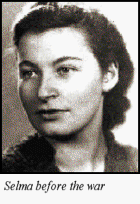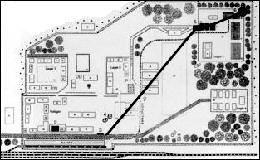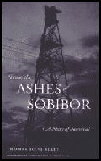Sobibor. A little village in
Poland. During World War 2 there was a certain
place nearby this little village, a place that
brought death. That certain place went into
history under the same name as the village. It
was the extermination camp of Sobibor, the place
where about 260.000 Jews were murdered during the
war, in the period between summer 1942 and fall
1943. It is a miniscule place on earth but were
so much horror took place at that time. This is
why I created an internet site about it.
Camp Sobibor is the most forgotten place, almost
nothing has been written on it so far, only a
couple of books, some by survivors. But that
remote forbidden place in Poland during the war
brought so much death that we are not allowed to
forget what happened there. We owe it to the
victims who died in Sobibor and to the ones who
survived. Only 47 survived the war after the
escape on 14 oktober 1943.
The only Dutch survivor is a woman named Selma Engel-Wijnberg (born as Saartje Wijnberg) . She lived in the city I live
in, Zwolle, and her family had a Hotel/Restaurant
at Veemarkt 23. My granddad knew her family well.
Most of Zwolle's Jews died in camp Sobibor and it
is also to their rememberance that I created this
page. Of course we may not forget all the other
ones who died at Sobibor. . She lived in the city I live
in, Zwolle, and her family had a Hotel/Restaurant
at Veemarkt 23. My granddad knew her family well.
Most of Zwolle's Jews died in camp Sobibor and it
is also to their rememberance that I created this
page. Of course we may not forget all the other
ones who died at Sobibor.
There is not much material on the Sobibor camp.
Everyone knows about Auschwitz/Birkenau or other
well known camps in Poland and elsewhere because
there is written, audio and video material enough
about it, but about the most three deadly ones it
is hard to find anything. Treblinka, Belzec and
Sobibor were the only of their kind (Chelmno not
included because it was not a part of Aktion
Reinhard) and these three didn't exist
till the end of the war like all the other ones;
they were broken down long before the war ended,
however more than 1.700.000 Jews were killed in
these three camps in only one and a half year
time. Also, Auschwitz/Birkenau's capacity grew
during the year 1943 so the three camps were not
longer needed. Belzec was shut in March 1943,
Treblinka in December 1943 and Sobibor in Oktober
1943. The remarkable fact that in Sobibor a
revolt and mass escape took place makes the camp
special.
Some more info about the camp
 Camp
Sobibor was
divided into four sections and a pre-camp where
the Germans were housed. On the left you can see
a drawing of Sobibor and its parts. On top the
railroad track and station of the camp where all
the trains stopped and the people were forced out
of the wagons they were in. The selections also
took place here on the so called Rampe.
The trolly track directly lead from the Rampe to
the graves in Lager III. Lager I was the part of
the camp where the prisoners lived and worked. It
was right behind the pre-camp (left side of
picture, below). Lager II, used for sorting and
storing goods, was about in the middle of the
camp. In between Lager II and Lager III there was
also a strip where planes could land and take
off. Lager IV was build later (bottom rightside
picture). The camp was build near the
railroadtrack from Chelm to Wlodowa. A garden for
growing vegetables was in between Lager I and
Lager II. Just short before the ones going
through the Schlauch (Himmelfahrtsallee) entered
the gaschambers they went through the
barbersbaraks where their hair was cut off. In
Lager III there were 2 massgraves and a
burningsite.The prisoners of Lager III also lived
inside this part of the camp and never came out.
Later the number of gaschambers was doubled to
six. The precamp was the part were the Germans
lived. It was short behind the station were the
trains stopped. The Ukrainian guards had several
baraks on different places in the camp. Camp
Sobibor was
divided into four sections and a pre-camp where
the Germans were housed. On the left you can see
a drawing of Sobibor and its parts. On top the
railroad track and station of the camp where all
the trains stopped and the people were forced out
of the wagons they were in. The selections also
took place here on the so called Rampe.
The trolly track directly lead from the Rampe to
the graves in Lager III. Lager I was the part of
the camp where the prisoners lived and worked. It
was right behind the pre-camp (left side of
picture, below). Lager II, used for sorting and
storing goods, was about in the middle of the
camp. In between Lager II and Lager III there was
also a strip where planes could land and take
off. Lager IV was build later (bottom rightside
picture). The camp was build near the
railroadtrack from Chelm to Wlodowa. A garden for
growing vegetables was in between Lager I and
Lager II. Just short before the ones going
through the Schlauch (Himmelfahrtsallee) entered
the gaschambers they went through the
barbersbaraks where their hair was cut off. In
Lager III there were 2 massgraves and a
burningsite.The prisoners of Lager III also lived
inside this part of the camp and never came out.
Later the number of gaschambers was doubled to
six. The precamp was the part were the Germans
lived. It was short behind the station were the
trains stopped. The Ukrainian guards had several
baraks on different places in the camp.
copyrights 1998 by Micha
Kersten
Zwolle, the Netherlands
hosted by: Sisanit

|


 . She lived in the city I live
in, Zwolle, and her family had a Hotel/Restaurant
at Veemarkt 23. My granddad knew her family well.
Most of Zwolle's Jews died in camp Sobibor and it
is also to their rememberance that I created this
page. Of course we may not forget all the other
ones who died at Sobibor.
. She lived in the city I live
in, Zwolle, and her family had a Hotel/Restaurant
at Veemarkt 23. My granddad knew her family well.
Most of Zwolle's Jews died in camp Sobibor and it
is also to their rememberance that I created this
page. Of course we may not forget all the other
ones who died at Sobibor. Camp
Sobibor was
divided into four sections and a pre-camp where
the Germans were housed. On the left you can see
a drawing of Sobibor and its parts. On top the
railroad track and station of the camp where all
the trains stopped and the people were forced out
of the wagons they were in. The selections also
took place here on the so called Rampe.
The trolly track directly lead from the Rampe to
the graves in Lager III. Lager I was the part of
the camp where the prisoners lived and worked. It
was right behind the pre-camp (left side of
picture, below). Lager II, used for sorting and
storing goods, was about in the middle of the
camp. In between Lager II and Lager III there was
also a strip where planes could land and take
off. Lager IV was build later (bottom rightside
picture). The camp was build near the
railroadtrack from Chelm to Wlodowa. A garden for
growing vegetables was in between Lager I and
Lager II. Just short before the ones going
through the Schlauch (Himmelfahrtsallee) entered
the gaschambers they went through the
barbersbaraks where their hair was cut off. In
Lager III there were 2 massgraves and a
burningsite.The prisoners of Lager III also lived
inside this part of the camp and never came out.
Later the number of gaschambers was doubled to
six. The precamp was the part were the Germans
lived. It was short behind the station were the
trains stopped. The Ukrainian guards had several
baraks on different places in the camp.
Camp
Sobibor was
divided into four sections and a pre-camp where
the Germans were housed. On the left you can see
a drawing of Sobibor and its parts. On top the
railroad track and station of the camp where all
the trains stopped and the people were forced out
of the wagons they were in. The selections also
took place here on the so called Rampe.
The trolly track directly lead from the Rampe to
the graves in Lager III. Lager I was the part of
the camp where the prisoners lived and worked. It
was right behind the pre-camp (left side of
picture, below). Lager II, used for sorting and
storing goods, was about in the middle of the
camp. In between Lager II and Lager III there was
also a strip where planes could land and take
off. Lager IV was build later (bottom rightside
picture). The camp was build near the
railroadtrack from Chelm to Wlodowa. A garden for
growing vegetables was in between Lager I and
Lager II. Just short before the ones going
through the Schlauch (Himmelfahrtsallee) entered
the gaschambers they went through the
barbersbaraks where their hair was cut off. In
Lager III there were 2 massgraves and a
burningsite.The prisoners of Lager III also lived
inside this part of the camp and never came out.
Later the number of gaschambers was doubled to
six. The precamp was the part were the Germans
lived. It was short behind the station were the
trains stopped. The Ukrainian guards had several
baraks on different places in the camp.